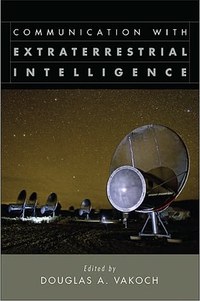Review: Communication with Extraterrestrial Intelligenceby Jeff Foust
|
| The book’s title is in part an homage to a 1973 book of the same title edited by Carl Sagan, but also indicates that its subject matter includes not just listening for signals but also transmitting them. |
Into this unsettled environment comes Communication with Extraterrestrial Intelligence, a wide-ranging look at many elements of SETI and beyond. The book serves the proceedings of the 2010 Astrobiology Science Conference (the “Woodstock for astrobiologists”, as the book’s foreword describes the event), which focused on SETI. The first third of the book features a set of papers on various aspects of SETI, from technical examinations of SETI issues, like the effect of the ionized interstellar medium on the propagation of transmissions, to review papers on the status of various radio and optical SETI searches in the United States and other countries.
The book’s title, though, hints at something more. In the preface, editor Douglas Vakoch explains that the title is in part an homage to a 1973 book of the same title edited by Carl Sagan that featured the proceedings of a 1971 US-USSR joint conference on SETI, which at time was more commonly called CETI. It’s also, Vakoch writes, intended to capture “the potentially bidirectional nature of an exchange between civilizations,” although in timescales best measured in centuries or millennia. The second and third parts of the book examine the technical and societal issues associated with transmitting messages into the universe, what’s known as messaging to extraterrestrial intelligence (METI), or often simply “active SETI”.
The concept of active SETI is somewhat controversial, as some fear that by deliberately broadcasting our presence to other worlds, we’re signaling our presence to potentially hostile civilizations—a view espoused by, among others, Stephen Hawking (see “SETI at 50”, The Space Review, August 23, 2010). That debate is addressed, although not resolved, in the second part of the book, which examines some of the issues associated from active SETI, from the concerns expressed by people like Hawking to the issues of international law associated with radio transmissions. The third part of the book, though, assumes such messages will go forward, and explores the challenge of crafting a message that could be understood by a civilization we know nothing about, including whether it even exists.
As with any collection of conference papers, the style of the individual papers varies, something especially true for an interdisciplinary subject like this: some go into great technical detail, with equations and charts, while others take a high-level approach to their subject matter. (One unfortunate aspect of the book is the lack of biographical information—even institutional affiliations—for the authors of the papers. While some, like Jill Tarter, Seth Shostak, and Paul Horowitz, are well known for those who have followed SETI, many others are not.) Overall, the papers in Communication with Extraterrestrial Intelligence provide a good handle on the state of thought in both passive and active SETI. Now, about that funding…
